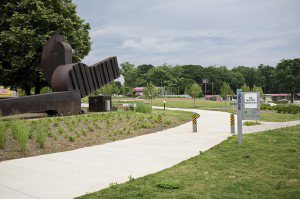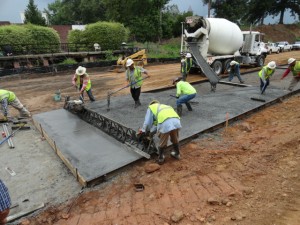By Erica Rascón on December 4, 2013 in News
The Atlanta BeltLine’s Westside Trail is slated to finish two to three years earlier than expected, even with a few delays due to a rainy summer this year.
The good news comes after the project received a recent wave of grants. The US Department of Transportation awarded an $18 million grant in early September. Called Tiger V, the grant will supply about 42 percent of the project’s total cost. This is a huge step for the BeltLine. With the funds, an additional 2.5 mile portion of the trail’s southwest corridor will be completed. To access the trail, residents and guests will gain access to 16 ADA accessible entry points as well as pedestrian overpasses at nine crossroads.
Upon receiving the grant, Mayor Kassim Reed lauded the project as “one of the most transformative projects ever undertaken in our city’s history.” He continued, “This $18 million grant is a tremendous step forward in my administration’s goal to make the vision of the Atlanta BeltLine a reality much sooner.”
 Paul Morris, President and CEO of Atlanta BeltLine, Inc., expressed his gratitude for the award. “We are extremely grateful to the U.S. DOT for this opportunity to deliver such a significant part of the Atlanta BeltLine in southwest Atlanta years ahead of schedule,” said Morris.
Paul Morris, President and CEO of Atlanta BeltLine, Inc., expressed his gratitude for the award. “We are extremely grateful to the U.S. DOT for this opportunity to deliver such a significant part of the Atlanta BeltLine in southwest Atlanta years ahead of schedule,” said Morris.
In mid-September, the BeltLine received a $20,000 grant from REI, which is double the outdoor supplier’s contribution last year. The funds will be allocated towards new mile markers and signage along an 8.2 portion of the trail. Funds will also be set aside for ongoing management operations.
To keep the extensive trail network safe and enjoyable for everyone, the BeltLine has received its own security force. The Path Force formed this July after receiving a $1.8 million grant from the U.S. Department of Justice COPS last year. The team is comprised of military veterans who now serve on the local police force. Though the officers’ beats will keep them close to the trails and parks, their presence creates a unified approach to security throughout the neighborhoods connected by the BeltLine.
All of the grants are significant contributions to the early completion of the project. Many of The BeltLine’s original delays were based upon funding. Atlanta residents, who first got wind of the project back in 1999, have been waiting on a completed BeltLine ever since; the BeltLine failed to gain local support on multiple occasions after it was unfavorably bundled with other tax-heavy projects. Local supporters have been in limbo ever since. If the project is completed by 2015 at the earliest, it has still been 16 years in the making.
Yet all good things are worth the wait. The Beltline, even in its early stages, has shown itself to be a promising addition to the city. The network will unite Atlanta’s neighborhoods and resources like never  before. The BeltLine also serves as an economic catalyst. The Eastside Trail has already prompted nearly $775 million in private real estate development in the area. Historic Fourth Ward Park, recent recipient of the Project of the Year award by ULI Atlanta, has sparked $400 million in real estate development. By revitalizing underserved and underutilized parts of the city, multifamily firms, businesses, and organizations are discovering new opportunities for growth and service in communities that need it most.
before. The BeltLine also serves as an economic catalyst. The Eastside Trail has already prompted nearly $775 million in private real estate development in the area. Historic Fourth Ward Park, recent recipient of the Project of the Year award by ULI Atlanta, has sparked $400 million in real estate development. By revitalizing underserved and underutilized parts of the city, multifamily firms, businesses, and organizations are discovering new opportunities for growth and service in communities that need it most.
If all goes according to plan, the completed BeltLine will prove to be an attractive asset to Atlanta Millennials. The young adults have proven to contribute their skills, talents, and financial support to cities that place sustainability and a sense of community in the foreground. Atlanta lags woefully behind other major cities in terms of eco-friendly development, public transit options and accessible green space. The Atlanta BeltLine might just bridge the gap, helping to drawn (and keep) the next generation of entrepreneurs and philanthropists in Georgia.


